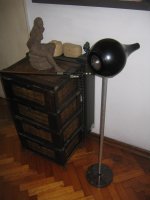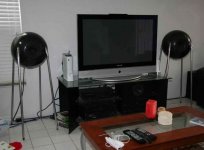polystyrene commercial fishing floats?
they are very tough. you can stand on one on a soft floor without leaving a mark in the polystyrene.
Use a big one to make a negative mould for the outside.
smaller one for the inside, remove it afterward with a solvent.
Use the holes through the middle of the floats to keep it in the right place. Remember it will have a LOT of floatation in concrete. it will try to rise to the surface with more force than in water.
they are very tough. you can stand on one on a soft floor without leaving a mark in the polystyrene.
Use a big one to make a negative mould for the outside.
smaller one for the inside, remove it afterward with a solvent.
Use the holes through the middle of the floats to keep it in the right place. Remember it will have a LOT of floatation in concrete. it will try to rise to the surface with more force than in water.
If you would like to do something in wood, visit the "WEST" System Epoxy projects web-page:
http://www.westsystem.com/cgi-bin/ewmag_readproj.pl
http://www.westsystem.com/cgi-bin/ewmag_readproj.pl
Alright ....I guess I'm going to give up the idea of cement spheres.
I'm seriously thinking about going the metal bowl route. Sounds pretty easy to build.
So, If I screw two bowls together, cut out a hole for my speaker, and other small one in the back for wiring, make a caulk seal for the speaker and stuff the thing with Poly-Fill, I should be good ...right? I'm going to start looking at some local restaurant supply stores.
Also, is there a difference between polyfill and the stuffing you can get in the craft department of Wally World??
I'm seriously thinking about going the metal bowl route. Sounds pretty easy to build.
So, If I screw two bowls together, cut out a hole for my speaker, and other small one in the back for wiring, make a caulk seal for the speaker and stuff the thing with Poly-Fill, I should be good ...right? I'm going to start looking at some local restaurant supply stores.
Also, is there a difference between polyfill and the stuffing you can get in the craft department of Wally World??
Spherical/ Tear Drop shaped loudspeaker
I have dabbled in aluminum spun tear drop shaped loudspeakers. However I have a lot more testing to do. The main thing about using aluminum is to damp it properly. I am not sure what is the best way to do this. Anybody have any ideas? Any info would be appreciated.
I have achieved best results with rubber paint (white paint used on roofs for waterproofing), about 4 coats. And then internal stuffing to reduce standing waves. My speakers are really quite small, with outer diameter is about 7 inches inches and after damping is put in there is an internal volume of at least 2.5 liters.
I thing the key is to get the resonant frequency of the aluminum cabinet to be 4 khz. And then dampen. In order to do this the following might help.
Next steps,
1. Use thicker aluminum (1.8 vs 1.2 mm) Or even thicker if possible!
2. Inner threaded rod connecting driver magnet to the outside and tightening.
3. Hard anodize the aluminum after a good polishing (increase stregth) (maybe heating it helps too, using quenching techniques - not sure)
4. ?????? (any one have any ideas)
5. possible internal bracing, not sure how to do this (maybe using fiberglass internally)
6. ???????
7.?????
I made the shape for tangband 3 inch drivers with output down to 70 hz (actually got these results with the appropriate drivers). However best results were gotten from 3 inch modified w3 881 drivers using Mark's modifications and sealed enclosure (used with subwoofer).
I have left a pic of the speakers.
Once I get the cabinet were I want them maybe I could start selling them. They would be great reference cabinets for all the full range 3 inch drivers out there. Also can be used for 4 inch driver without the front plate as long as the back magnet is used for bracing (with rubber gasket).
Any thoughts would be helpfull 🙂
I have dabbled in aluminum spun tear drop shaped loudspeakers. However I have a lot more testing to do. The main thing about using aluminum is to damp it properly. I am not sure what is the best way to do this. Anybody have any ideas? Any info would be appreciated.
I have achieved best results with rubber paint (white paint used on roofs for waterproofing), about 4 coats. And then internal stuffing to reduce standing waves. My speakers are really quite small, with outer diameter is about 7 inches inches and after damping is put in there is an internal volume of at least 2.5 liters.
I thing the key is to get the resonant frequency of the aluminum cabinet to be 4 khz. And then dampen. In order to do this the following might help.
Next steps,
1. Use thicker aluminum (1.8 vs 1.2 mm) Or even thicker if possible!
2. Inner threaded rod connecting driver magnet to the outside and tightening.
3. Hard anodize the aluminum after a good polishing (increase stregth) (maybe heating it helps too, using quenching techniques - not sure)
4. ?????? (any one have any ideas)
5. possible internal bracing, not sure how to do this (maybe using fiberglass internally)
6. ???????
7.?????
I made the shape for tangband 3 inch drivers with output down to 70 hz (actually got these results with the appropriate drivers). However best results were gotten from 3 inch modified w3 881 drivers using Mark's modifications and sealed enclosure (used with subwoofer).
I have left a pic of the speakers.
Once I get the cabinet were I want them maybe I could start selling them. They would be great reference cabinets for all the full range 3 inch drivers out there. Also can be used for 4 inch driver without the front plate as long as the back magnet is used for bracing (with rubber gasket).
Any thoughts would be helpfull 🙂
Attachments
A local military-surplus yard has very strong plastic fishing floats of 300mm diameter. These have a moulded-in tunnel through the middle so they can be placed on a line like beads. It would be easy to cut out a speaker hole at one end of the tunnel. You could either cut out a smaller circle around the other end of the tunnel to fit the connection plate, or possibly even calculate if a portion of the tunnel could be left in to provide a bass-reflex port. (the tunnel internal diameter is about 30mm, and it has a nice flared end).
i have just got some of the ikea bowls for my Bandor 50mm drive units, should be good 😀
http://www.hifiwigwam.com/forum19/23854.html
http://www.hifiwigwam.com/forum19/23854.html
- Status
- Not open for further replies.
- Home
- Loudspeakers
- Multi-Way
- How do I make spherical enclosures?


